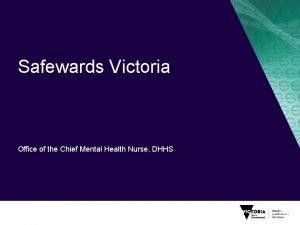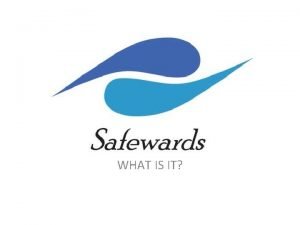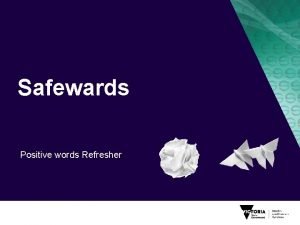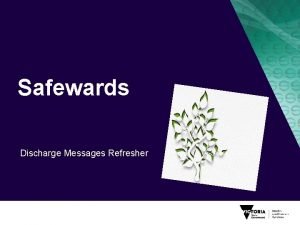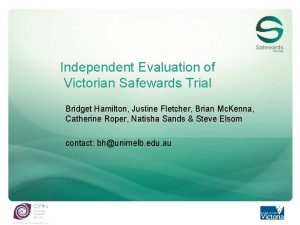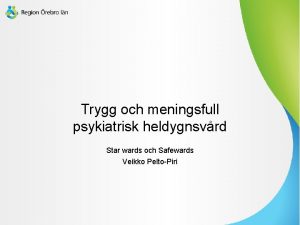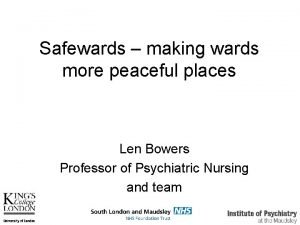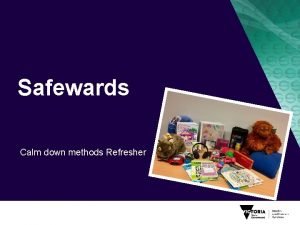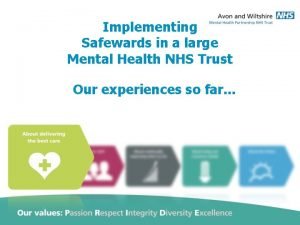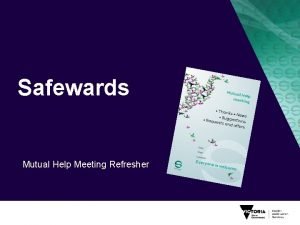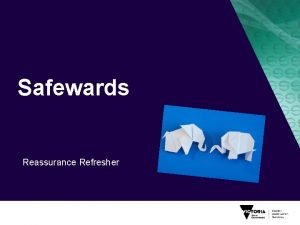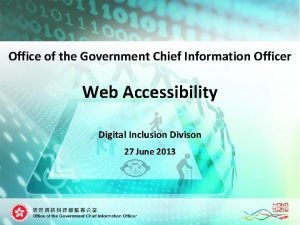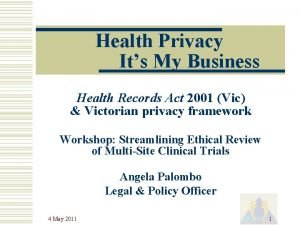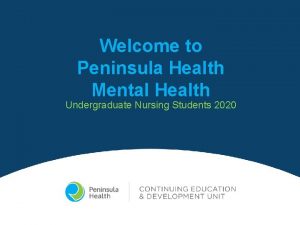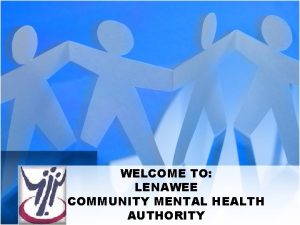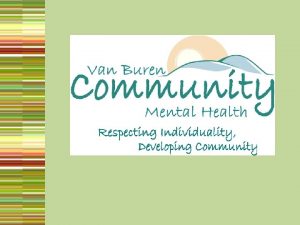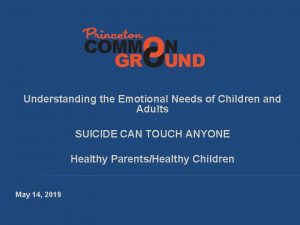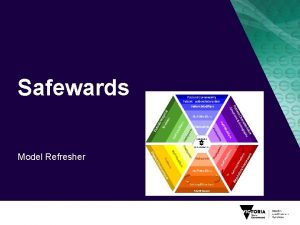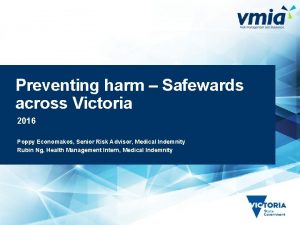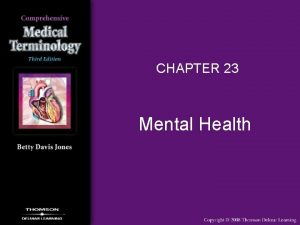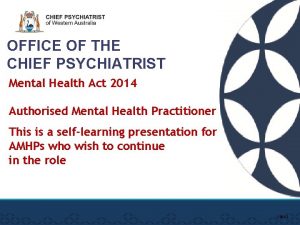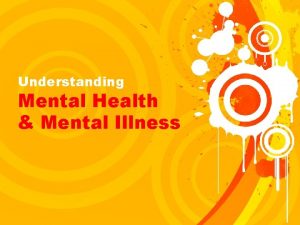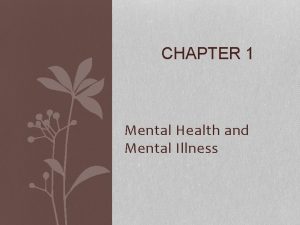Safewards Victoria Office of the Chief Mental Health
























- Slides: 24

Safewards Victoria Office of the Chief Mental Health Nurse, DHHS


Why Safewards? A response to two high priority issues: • Restrictive interventions • Occupational violence Supporting drivers: • Mental Health Act (2014) • Reducing Restrictive Interventions state-wide project • Reducing Restrictive Interventions Framework • Sector interest

Moving away from Restrictive interventions Fight response Staff Fear/ anger Cultures of control Occupational violence Patient fear/ anger Fight response Violence Trauma Illness / Inj ury

Moving toward Therapeutic interventions Trust & hope Staff safety Cultures of care Connection & understanding Patient safety Trust & hope Recovery Safety Learning

What is Safewards?

The Safewards basics • Model of practice for mental health settings • Focus on reducing conflict (violence & risk of harm) and containment (restrictive practices) • Solid evidence base (UK and Victoria) • Model and ten interventions • Implementation: 2014 -15 Pilot and evaluation 2017 -18 Implement in mental health inpatient units 2019 -20 Implement in EDs and general units

Conflict and Containment Safewards centres around reducing conflict and containment Containment (what staff do to prevent conflict events or minimise harmful outcomes) may include: • Special observation Physical aggression • Use of security Verbal aggression • Physical restraint Self harm/ suicide • Chemical restraint Substance misuse • Seclusion Property damage • Mechanical restraint Absconding Medication refusal These behaviours could • Environmental restraint potentially lead to restrictive interventions Conflict means anything that could lead to harm for the patient, other patients or staff: • •

Technical Safewards Model & Interventions Ten Interventions 1. Know each other 2. Clear mutual expectations 3. Discharge messages 4. Positive words 5. Soft words 6. Reassurance 7. Mutual help meeting 8. Bad news mitigation 9. Talk down methods 10. Calm down methods

Simple Safewards Model Staff modifiers Patient modifiers Originating domains Flashpoints Conflict Containment

The interventions Origina ting domain s Know Each Other Patients and staff share some limited personal information with each other. u Builds rapport, respect & common humanity Clear Mutual Expectations Patients & staff work out mutually agreed aspirations that apply to both groups equally. u Counters some power imbalances Positive Words Staff say something positive in handover re each patient, & use psychological explanations for challenging actions. u Increases positive appreciation and helpful information about working with patients.

The interventions Patient Modifie rs Discharge Messages Patients leave messages of hope for other patients. u Strengthens patient community & hope Mutual Help Meeting Patients offer and receive mutual help and support. u Strengthens patient community, coping

The interventions Flashpo ints Reassurance Staff debrief every patient after every conflict on the unit. u Increases patients’ sense of safety, reduces conflict Bad News Mitigation Staff understand, plan for & mitigate the effects of bad news received by patients u Reduces likelihood of conflict Soft Words Staff rethink limits on patients: reduce limits and/or increase options and respect in limit setting u Promotes respect, choice & dignity

The interventions Conflic t Calm Down Methods Staff use patient’s own strengths & coping strategies, or explore new ones, before using PRN medication. u Strengthen patient coping, skills, resources Talk Down Staff use consistent de-escalation process emphasising self-control, respect & empathy, with a focus on clarifying issues and finding resolution together. u Respect, mutually positive outcomes

Some practical ideas

Priorities for Tribunal staff Common staff modifiers for staff: • Protecting the rights and dignity of people • Using supportive decision making (nominated persons) • Creating least restrictive environments and least restrictive practice (e. g. voluntary treatment) • Key interventions: • • • Positive words Bad news mitigation Know each other Soft words Talk Down Calm down methods

Positive Words Staff say something positive in handover about each patient, & use psychological explanations for challenging actions. u Increases positive appreciation and helpful information about working with patients. Supporting document: ‘Understanding patient characteristics and experiences’

Bad News Mitigation Staff understand, plan for & mitigate the effects of bad news received by patients u Reduces likelihood of conflict Key messages: • Inform the team when you are giving news that might be upsetting • When delivering bad news, be respectful, provide as many choices as possible, give people time and space, offer ongoing support • If people get bad news from outside hospital, respond promptly & offer ongoing support

Know Each Other Patients and staff share some limited personal information with each other. Know each other u Builds rapport, respect & common humanity ble availa s e t a l Temp

Soft Words Staff rethink limits on patients: reduce limits and/or increase options and respect in limit setting u Promotes respect, control & dignity u Reduces likelihood of conflict Key messages • Recognise that limits have an enormous impact – the most common flashpoint • Ask yourself first: Do you really need to set the limit? • Can you provide choice within the limits? • How can you maximise the person’s autonomy, dignity and human rights?

Talk Down Staff use consistent de-escalation process emphasising self-control, respect & empathy, with a focus on clarifying issues and finding resolution together. u Respect, mutually positive outcomes

Calm Down Methods Staff use patient’s own strengths & coping strategies, or explore new ones, before using PRN medication. u Strengthen patient coping, skills, resources Key messages: • Think twice about PRN • Consider alternatives to medication that can be sustained post admission - Support people to draw on existing strengths & coping mechanisms - Facilitate learning of new strengths and skills

Find out more www. health. vic. gov. au/ safewards

 Safewards victoria
Safewards victoria Chapter 9 lesson 3 commander in chief and chief diplomat
Chapter 9 lesson 3 commander in chief and chief diplomat Habitos de la victoria privada
Habitos de la victoria privada Chapter 20 mental health and mental illness
Chapter 20 mental health and mental illness Stress management jeopardy
Stress management jeopardy Soft words safewards
Soft words safewards Safewards talk down
Safewards talk down Safewards positive words
Safewards positive words Discharge messages
Discharge messages Safewards 10 interventions
Safewards 10 interventions Safewards sverige
Safewards sverige Len bowers safewards
Len bowers safewards Signs of agitation
Signs of agitation Soft words safewards
Soft words safewards Mutual help meeting
Mutual help meeting Talk down safewards
Talk down safewards Office of the government chief information officer
Office of the government chief information officer Usda office of the chief financial officer
Usda office of the chief financial officer Chief scientist scotland
Chief scientist scotland Australian privacy principles
Australian privacy principles Aparc frankston
Aparc frankston Lenawee community mental health authority
Lenawee community mental health authority Van buren cmh
Van buren cmh Chapter 3 lesson 3 expressing emotions in healthful ways
Chapter 3 lesson 3 expressing emotions in healthful ways Together for mental health
Together for mental health
